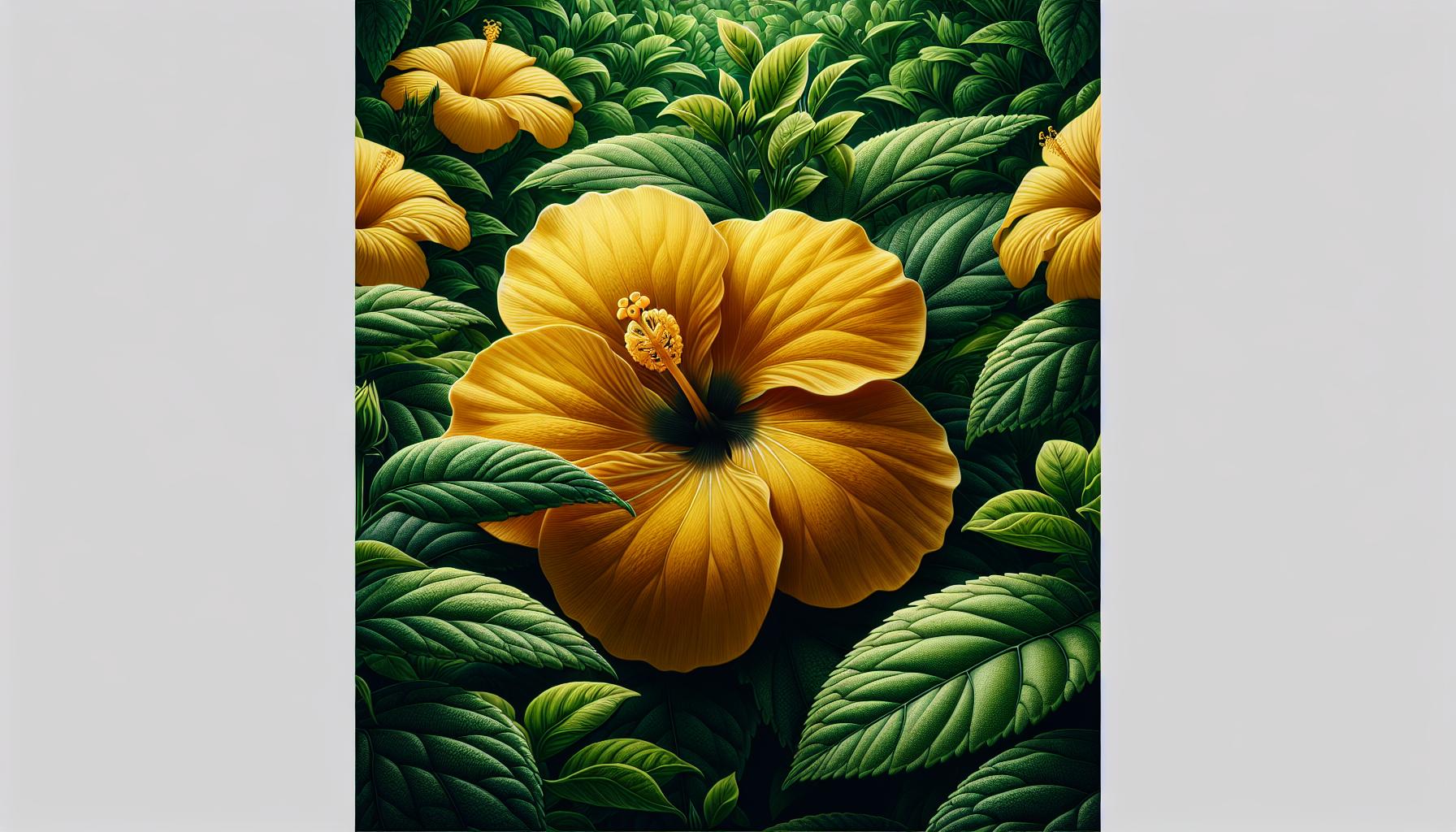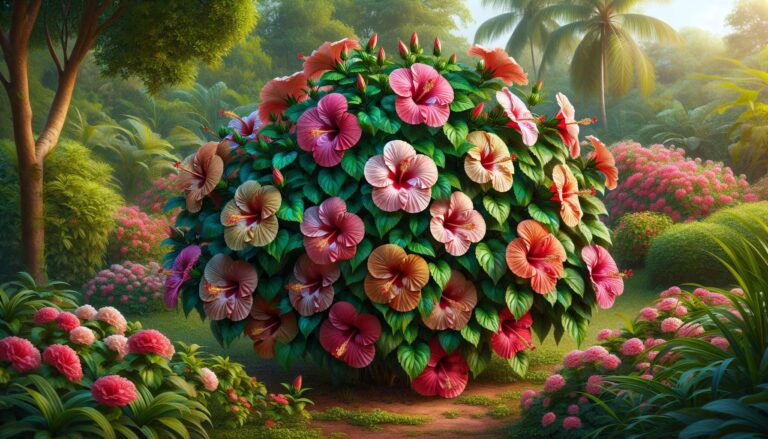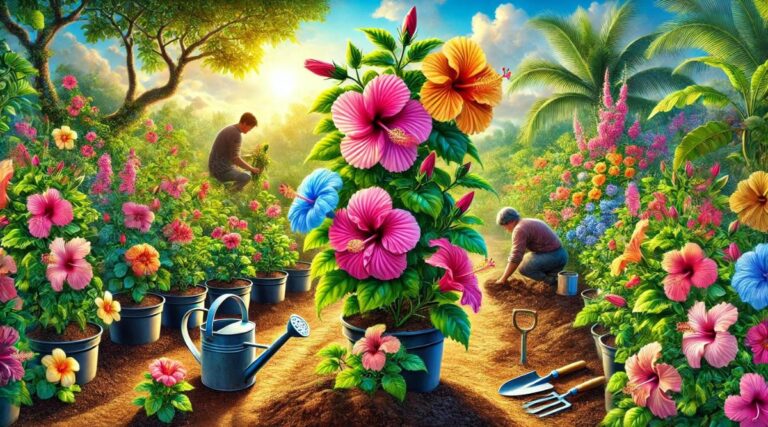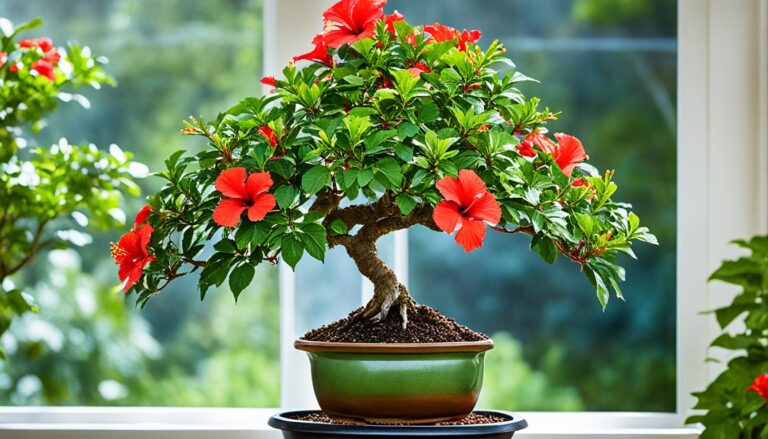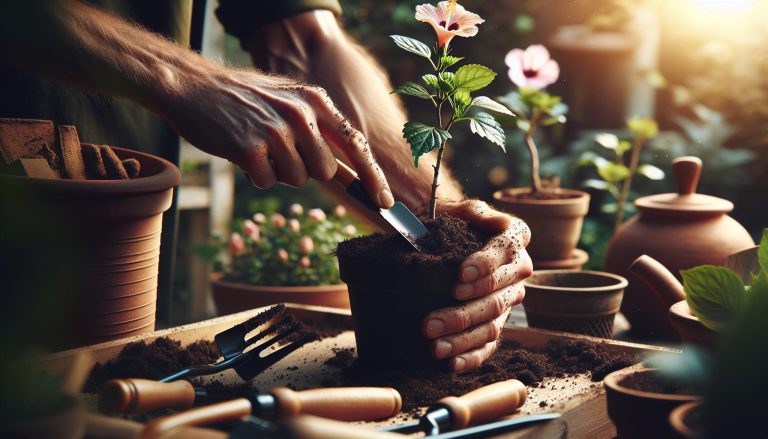Yellow Hibiscus Care: Grow Hawaii’s Iconic Flower Successfully
Nestled within the lush landscapes of Hawaii, the yellow hibiscus flower, or pua mao hau hele, stands as a vibrant emblem of the islands’ rich flora. Since its designation as the official state flower in 1988, this striking bloom has not only captured the hearts of locals but has also intrigued plant enthusiasts worldwide. Its large, sun-kissed petals and unique blooming schedule, opening in the late afternoon and closing by midday, make it a fascinating subject of admiration.
However, the beauty of the yellow hibiscus extends beyond its visual appeal. As one of the seven species of hibiscus native to Hawaii, it plays a crucial role in the islands’ ecological and cultural heritage. Despite its significance, all three subspecies of the yellow hibiscus are listed as endangered, highlighting the need for conservation efforts. Our journey into the world of the yellow hibiscus not only celebrates its beauty but also underscores the importance of preserving Hawaii’s natural treasures for future generations.
Key Takeaways
- The yellow hibiscus, known as “pua mao hau hele,” is the official state flower of Hawaii, symbolizing warmth, friendship, and respect, and playing a vital role in Hawaiian ceremonies and traditions.
- This endangered species is crucial for the biodiversity and ecological health of Hawaii, highlighting the importance of conservation efforts to preserve these natural treasures.
- Ideal growing conditions for the yellow hibiscus include full sunlight, fertile, loamy soil with good drainage, and consistent watering to meet the plant’s high moisture needs.
- Practical care steps for thriving yellow hibiscus plants involve selecting the right location, preparing the soil, correct planting practices, regular watering, fertilizing, pruning, and frost protection.
- Common challenges such as pests, diseases, and environmental stress can be managed through vigilant care, using natural pest control methods, and adjusting care according to seasonal changes.
- Propagation by seeds offers the potential for genetic diversity but with uncertain outcomes, while cuttings ensure the replication of desired traits, with both methods supporting the conservation and spread of this species.
Overview of the Yellow Hibiscus Flower
The Symbolism and Significance
Delving deeper into the yellow hibiscus flower, its symbolism and significance cannot be overstated. Known in Hawaiian as “pua mao hau hele,” this vibrant flower embodies the Aloha spirit, representing warmth, friendship, and respect. It’s not just a symbol of casual beauty; it stands as a profound emblem of what Hawaii offers – hospitality, beauty, and a connection with nature.
The yellow hibiscus flower also plays a crucial role in Hawaiian ceremonies and traditions. For instance, wearing this flower behind the ear at Hawaiian events signifies one’s relationship status, adding a layer of personal significance to its already rich cultural meaning. Moreover, this flower’s inclusion in lei making highlights its importance in Hawaiian culture, connecting people to their history and tradition.
In addition to its cultural importance, the yellow hibiscus has ecological value. As one of the native species, it contributes to the biodiversity and health of Hawaiian ecosystems. Given its endangered status, the yellow hibiscus flower also represents the delicate balance of Hawaii’s unique environment, reminding us of the need for conservation and sustainable practices to maintain this balance.
Varieties and Characteristics
The yellow hibiscus, while globally recognized, manifests in several varieties, each with unique characteristics. These varieties showcase different shades of yellow, from pale lemon to deep gold, and diverse forms and sizes of blooms. Some varieties feature a single layer of petals, while others flaunt double layers, offering a spectacular display.
The growth habits of the yellow hibiscus vary widely. Some grow as small shrubs that fit perfectly in a garden setting, while others can reach the size of small trees, creating a statement piece in any landscape. Despite these differences, all varieties share the trait of thriving in full sunlight, making them ideal for the Hawaiian climate where they receive ample sunshine.
Another notable characteristic is their blooming pattern. Unlike some flowers that bloom all year round, the yellow hibiscus has a more selective blooming schedule, adding to its uniqueness. This selective blooming does not diminish its beauty; instead, it makes each bloom even more special and anticipated.
In caring for the yellow hibiscus, certain needs must be met including well-draining soil and regular watering, highlighting its relatively low-maintenance nature. This feature ensures that even those new to gardening can enjoy the beauty and significance of the yellow hibiscus in their own gardens.
Through its cultural significance, ecological value, and striking beauty, the yellow hibiscus flower stands as a testament to Hawaii’s rich heritage and serves as a symbol of the state’s commitment to preserving its natural treasures.
Ideal Growing Conditions

Cultivating the vibrant yellow hibiscus flower, Hawaii’s proud state flower, involves understanding and meeting its specific growing conditions. Thriving in the right environment, this flower can illuminate any garden with its warm hues and trumpet-shaped blooms. Let’s dive into the ideal growing conditions necessary to nurture these radiant beauties.
Light Requirements
The yellow hibiscus flower performs best in areas that receive plenty of sunlight. While it is a tropical plant by nature, its light requirements slightly vary depending on the geographical location. In warmer and arid regions, positioning the plant where it can receive partial shade, especially during the hottest parts of the day, optimizes its growth and bloom production. Conversely, in cooler climes, exposing the plant to direct sunlight ensures it gets the necessary warmth and light intensity for photosynthesis. When grown indoors, choosing a bright spot near a window that lets in ample light but shields the plant from the harsh, direct rays proves beneficial for its health and flowering.
Soil Preferences
A key component to the success of the yellow hibiscus is the quality of the soil it’s planted in. This flower thrives in fertile, loamy soil rich in organic matter. Soil that maintains consistent moisture yet offers good drainage is ideal, as it ensures the roots are sufficiently hydrated without being waterlogged. The plant prefers a slightly acidic soil pH, which can influence the vibrancy of its blooms. For gardeners working with nutrient-poor or poorly-draining soil, amending the earth with organic compost or using a well-draining potting mix for container-grown plants can make a world of difference. Additionally, mulching around the base of the plant helps retain soil moisture and regulate temperature, creating a conducive environment for the plant’s growth.
Watering Needs
Proper hydration plays a pivotal role in the cultivation of the yellow hibiscus flower. These plants demand frequent and consistent watering to sustain their lush foliage and support bloom production. During the growing season, from spring to early fall, it’s imperative to water the plant deeply and regularly. The goal is to keep the soil moist but not soggy, ensuring the plant receives enough water to meet its needs without causing root rot. In hotter, drier climates, daily watering might be necessary, especially for plants in containers or those exposed to full sun. As the seasons change, adjusting watering frequency to match the plant’s reduced water requirements during dormant periods ensures the yellow hibiscus remains vibrant year after year.
By meeting these essential light, soil, and watering conditions, we set the stage for the yellow hibiscus flower to not only grow but to thrive magnificently in our gardens. Cultivators can enjoy the breathtaking beauty and symbolic warmth this flower brings, ensuring it remains a cherished part of Hawaii’s natural heritage and our own floral collections.
How to Plant and Care for Yellow Hibiscus

Following the exploration of the yellow hibiscus’s significance and the optimal conditions for its growth, it’s crucial to delve into the practical steps for planting and maintaining these radiant flowers. Embedding the yellow hibiscus in your garden not only contributes to conservation efforts but also brings a piece of Hawaiian culture and its warm, inviting symbolism into your space.
Planting Steps
- Choose the Right Location: Emphasizing the yellow hibiscus’s need for sunlight, select a spot in your garden that receives direct sun for at least half to a full day. This ensures the plant gets the energy it needs for optimal growth and bloom production.
- Prepare the Soil: The yellow hibiscus thrives in well-drained soil. Enhance your garden bed or planter with organic matter to improve soil texture and fertility. This step promotes healthy root development and efficient water use.
- Dig the Right Sized Hole: For plants bought in a container, dig a hole twice as wide and just as deep as the root ball. This extra space allows the roots to expand easily into the surrounding soil.
- Position the Plant: Gently remove the hibiscus from its container, being careful not to disturb the roots. Place it in the center of the hole, ensuring the top of the root ball is level with or slightly above the surrounding soil to prevent waterlogging.
- Water Thoroughly: After planting, water the yellow hibiscus generously to settle the soil around the roots and eliminate air pockets. This initial deep watering supports the plant as it adapts to its new environment.
- Watering Needs: Check on the yellow hibiscus 2-3 times per week, watering whenever the top of the soil feels dry. The plant’s thirst for water requires consistent attention, especially during warmer months, to maintain moisture without waterlogging.
- Fertilizing: To encourage vibrant blooms, use a time-release fertilizer in spring or a general-purpose fertilizer monthly. This added nutrition supports the yellow hibiscus’s rapid growth and flowering capacity.
- Pruning: Regularly remove dead or overgrown branches to promote healthy growth and shape the plant. Pruning also encourages more blooms by redirecting the plant’s energy from developing unnecessary foliage to flower production.
- Protection: Given the yellow hibiscus’s sensitivity to cold, bring potted plants indoors or provide protection for garden-planted ones if a freeze is imminent. Consult your local frost dates to anticipate necessary protective measures.
Common Challenges and Solutions

Cultivating the vibrant yellow hibiscus, while rewarding, presents certain challenges, including pests, diseases, and environmental stress. By implementing effective solutions, gardeners can ensure their plants thrive, embodying the beauty and resilience of Hawaii’s state flower.
Tackling Pests and Diseases
Pests and diseases can significantly hinder the growth and bloom of yellow hibiscus plants. Aphids, spider mites, and whiteflies are common pests that feed on the sap of the plants, weakening them and potentially spreading diseases. Meanwhile, fungal infections such as root rot and rust can deteriorate the plant’s health if left untreated.
To combat these issues, we recommend regular monitoring of the plants for signs of pests and diseases. Applying neem oil or insecticidal soap can effectively control pest infestations, offering a natural solution that’s safe for the plant and the environment. For fungal diseases, ensuring proper drainage and avoiding overcrowding can help prevent their occurrence. In severe cases, applying a fungicide may become necessary, but it’s essential to use it as directed to avoid harming the plant and surrounding ecosystem.
Dealing with Environmental Stress
Environmental stressors, including extreme temperatures, improper lighting, and water stress, can adversely affect yellow hibiscus plants. Given their tropical origins, these plants thrive in warm conditions with ample sunlight. However, they can suffer in overly hot or cold temperatures, leading to leaf drop, bud fall, or inhibited growth.
Ensuring the plants receive enough, but not excessive, sunlight is crucial for their development. During particularly hot or cold spells, providing shade or shelter can protect the plants from extreme conditions. Proper watering practices, tailored to the plant’s needs throughout different seasons, also play a vital role in mitigating water stress. Mulching can help retain soil moisture and regulate temperature, further minimizing environmental stress.
By understanding and addressing these common challenges, we can nurture healthy, flourishing yellow hibiscus plants. Adopting these solutions not only aids in preserving the unique heritage and ecological significance of this species but also enhances our gardens with their stunning beauty.
Propagation Methods

In our ongoing discussion about the vibrant beauty and cultivation of the yellow hibiscus flower, we now turn our attention to effective propagation methods. Propagation plays a pivotal role in maintaining and enhancing the beauty of these magnificent flowers. Here, we’ll dive into the two most common propagation techniques: using seeds and cuttings. Each method has its unique advantages and challenges.
Seeds vs. Cuttings: Pros and Cons
Seeds:
Growing yellow hibiscus from seeds offers a sense of achievement from witnessing the growth process from the very beginning. Seeds can sometimes result in new, unique variations of hibiscus plants due to genetic diversity. However, propelling this beauty into existence isn’t without its challenges. Seeds require patience, as germination can be slow and the process from seed to flowering plant is lengthy. Furthermore, there’s no guarantee the seedlings will exhibit the same characteristics as their parent plant, including the exact shade of yellow or plant vigor.
Cuttings:
On the other hand, propagating yellow hibiscus through cuttings is like creating an exact clone of the parent plant. This method ensures the offspring will bear the same stunning yellow flowers and desired characteristics as the original. Cuttings tend to root relatively fast and can be more straightforward for beginners. The primary concern with cuttings involves potential disease transfer from the parent plant. It’s crucial to use healthy, disease-free plants and sterilize all tools before cutting.
Choosing between seeds and cuttings depends on one’s goals, resources, and level of patience. Whether looking to experiment with genetic variety through seeds or aiming for the exact replication of a favorite plant with cuttings, each method provides a pathway to propagate the cherished yellow hibiscus. By adhering to the right conditions and practices outlined in the previous sections, gardeners can ensure the successful growth and proliferation of this iconic and endangered species.
Landscape and Decorative Uses

In Garden Landscapes
Incorporating the yellow hibiscus into garden landscapes not only adds a burst of vibrant color but also infuses tropical flair into any setting. This striking flower serves as an excellent choice for foundation planting, creating an eye-catching display along house perimeters or fence lines. The glossy green foliage and bold yellow blooms enhance the aesthetic appeal of garden landscapes, making the yellow hibiscus a favorite for mixed borders or as an effective screen and hedge. Its long blooming cycle ensures a consistent display of color from spring through late summer, providing lasting interest and beauty.
Additionally, the yellow hibiscus is versatile enough to complement a variety of garden styles. In tropical-themed gardens, its bright flowers and lush foliage contribute to an authentic atmosphere, while in cottage gardens, the plant adds a touch of elegance and whimsy. For landscapes aiming to achieve a natural, wildlife-friendly approach, the yellow hibiscus’s nectar-rich flowers attract bees and butterflies, promoting biodiversity.
As Container Plants
Beyond its use in garden landscapes, the yellow hibiscus thrives as a container plant, offering flexibility and convenience for those with limited space or non-ideal soil conditions. Growing hibiscus in containers allows gardeners to control the growing environment more effectively, ensuring the plant receives the optimal soil mix, watering, and feed. The yellow hibiscus, with its compact growth habit, is particularly suited to container cultivation, making it an ideal addition to patios, balconies, and other outdoor living spaces.
Container-grown yellow hibiscus plants can easily be moved to optimize light exposure or protect them from adverse weather conditions, such as frost. This adaptability extends the blooming season and potentially the longevity of the plant. When placed strategically, potted yellow hibiscus plants serve as stunning focal points, drawing the eye with their brilliant blooms and adding a splash of color to any outdoor area.
Moreover, containers offer the opportunity for thematic garden displays. Combining yellow hibiscus with other tropical plants in a single large container or grouping individual pots creates a cohesive, visually impactful display that can transform any space into a vibrant tropical retreat.
Incorporating the yellow hibiscus into both garden landscapes and container arrangements, gardeners can enjoy the lush beauty and radiant charm of this versatile plant, enhancing the overall aesthetic of their outdoor spaces.
Conclusion
We’ve journeyed through the significance and beauty of the yellow hibiscus, understanding its critical role in Hawaiian culture and ecosystems. We’ve shared insights on how to nurture these radiant blooms, from selecting the perfect spot to ensuring they receive the care they need to thrive. By embracing the practices we’ve outlined, you’re not just cultivating flowers; you’re participating in the preservation of a symbol deeply rooted in tradition and natural beauty. Let’s continue to foster these stunning blooms in our gardens, ensuring their legacy and splendor endures for generations to come. Together, we can make a difference, one yellow hibiscus at a time.

